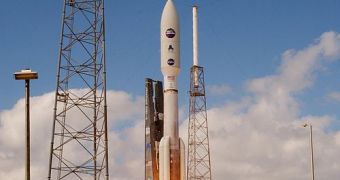Representatives from Boeing and Lockheed Martin – which together form the United Launch Alliance (ULA) – announce that the two companies will be moving towards certifying their established Atlas V delivery system for human spaceflight.
This will enable the rocket to compete against other contenders for carrying spacecraft such as the NASA Orion Multi-Purpose Crew Vehicle (MPCV). The capsule is scheduled to have its first flight test in 2013, with numerous others following over the next couple of years.
In addition to the MPCV, there are also several private companies developing spacecraft that may ultimately be used to carry astronauts to low-Earth orbit and beyond. Boeing is one such company, working under a CCDev2 contract with NASA to develop the CST-100 space capsule.
The potential benefits that ULA may rip from obtaining the human spaceflight classification for Atlas V are very well worth the initial investment in modifying the rocket accordingly. Recently, the Alliance announced the successful completion of its second required major performance milestone.
The Design Equivalency Review (DER) was conducted as part of a CCDev agreement between ULA and NASA. What the DER does is assess the degree of compliance between a proposed rocket and the NASA human spaceflight requirements list.
Of the four companies that are working on developing private, manned spacecraft for NASA, three have selected Atlas V as a prospective launch vehicle. If the rocket manages to get the appropriate classifications, then it could have a very busy decade ahead.
Before the DER was started, ULA engineers worked closely with NASA human spaceflight experts to analyze the extent to which the rocket met existing agency guidelines. At this point, Atlas V is already certified to carry highly-sensitive space missions, such as national security ones.
The vice president of business development and advanced programs, George Sowers, explains that the DER was not started from scratch. The rocket already has a track record of 27 successful missions under its belt, and this formed a solid foundation for the company.
“The Design Equivalency Review allowed the NASA team to compare their stringent human spaceflight requirements against the Atlas V design and demonstrated performance,” Sowers explains.
“The ULA team benefited greatly from NASA's insight and expertise. The completion of the DER is one more step towards confirming that Atlas V is the best choice for providing near-term, safe and affordable launch services for NASA human spaceflight,” he concludes, quoted by SpaceRef.

 14 DAY TRIAL //
14 DAY TRIAL //